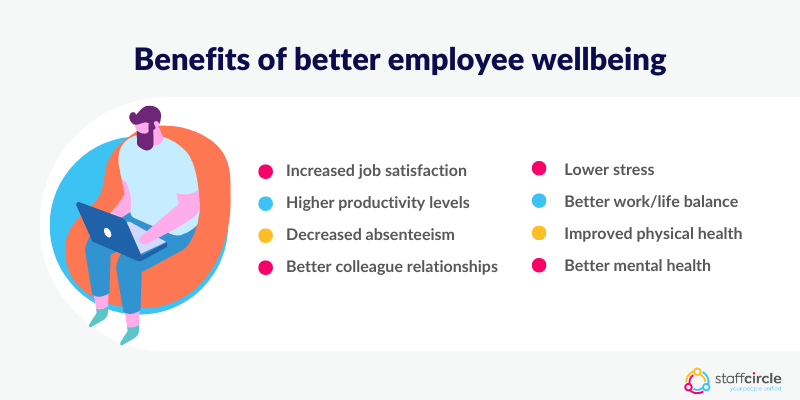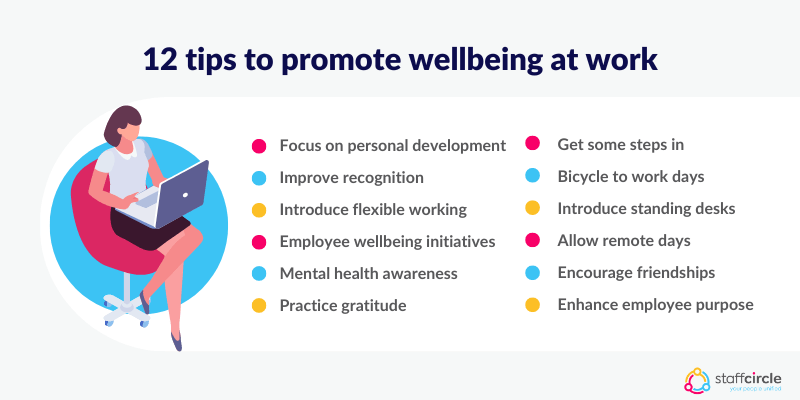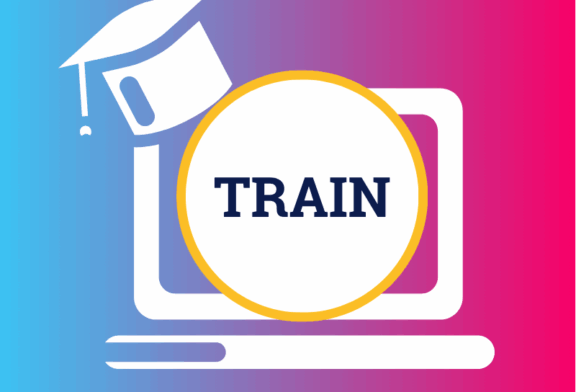Staff wellbeing is one of the core concerns among employers today, with physical and mental health concerns strongly impacted by the events of 2020 onwards.
As employees continue to report low levels of wellbeing, business leaders are increasingly adopting a range of measures to boost wellbeing and help staff improve their work-life balance.
Read on and find out how you can help alleviate workplace stress, reduce mental ill health, and support your workers to improve their health and wellbeing.
What does staff wellbeing mean?
Employee wellbeing relates to the physical and mental health of the workforce and is affected by a wide range of factors. A healthy work-life balance is one of the main drivers of wellbeing, but there are many other aspects of life than can impact wellbeing.
A report from Gallup sheds a worrying light on the state of wellbeing in the workplace, with an increasing number of employees feeling as if their employers don’t care about their wellbeing.
The article from Gallup, Percent Who Feel Employer Cares About Their Wellbeing Plummets, reports:
“Fewer than one in four U.S. employees feel strongly that their organization cares about their wellbeing — the lowest percentage in nearly a decade. This finding has significant implications, as work and life have never been more blended and employee wellbeing matters more than ever– to employees and the resiliency of organizations.”

How can improving staff wellbeing benefit your business?
There are a number of reasons why wellbeing is important, ranging from reducing the absence rates to increasing the number of A-players working for your company. Wellbeing initiatives help employees develop the necessary tools to maintain a healthy standard of physical and mental health, which increases their engagement and motivation while at work.
Some of the other benefits businesses experience when employees report healthy levels of wellbeing include:
- A general increase in job satisfaction
- Higher overall levels of productivity and quality work
- Decreased absenteeism and time off from work sick
- Happier employees with healthy relationships with their co-workers
- Lower reported levels of stress and anxiety
- Greater balance between work and life
- Better health outcomes, with lower blood pressure and improved heart health
- Lower levels of depression and other disruptive moods
- Better quality sleep, resulting in employees who feel refreshed and invigorated
You can remove mental health difficulties and improve employee wellbeing by focusing on the employee experience at every stage of your HR strategy. While some improvements might be large projects, there could be some quick changes that you can implement to see immediate benefits.
It’s important to consider that every micro-transaction an employee has with your business develops their overall view of you as an employer. Employee wellbeing isn’t just based on experiences and activities, it’s ingrained into the entire HR process.
From onboarding to performance reviews, you can improve employee retention by making changes that boost the overall employee experience. Our eBook “Employee Retention in 2022: Your Ultimate Guide” outlines the steps you can take to ensure a healthy and engaged workforce.

12 top tips to promote wellbeing at work
We’ve examined some of the reasons why improving staff wellbeing can improve your business. Now, let’s look at some effective ways you can promote wellbeing at work.
Focus on personal development
Employees who align their work tasks with their personal and professional development report higher levels of job satisfaction than those who don’t. The development of talents, skills, and strengths also has a positive impact on an employee’s confidence, driving them to excel in their performance.
A focus on personal development begins during the onboarding process with the creation of a personal development plan and continues throughout their time in the company. A PDP provides a coherent framework for future training and development, as well as coaching and mentorship programs to help them develop in their roles.
Consistent feedback through regularly scheduled one2one check-ins can help deliver additional guidance for employees to meet these development goals. This also offers the opportunity to adapt to change, take on new challenges, and develop a more comprehensive and diverse skill set.
Make recognition and praise part of your company culture
Competent business leaders are those who have a good handle on the dos and don’t of company culture, and understand the importance of praise and recognition for a healthy work environment. Effective recognition is timely and specific so that it can drive those behaviours which are most desirable.
Recognition can come in a range of forms, from a simple “thank you” to intrinsic rewards such as pay raises and bonuses. It can be carried out publicly, or if the employee being recognised has an introverted personality, conducted in a discreet manner for instance during one2one meetings.
Whatever the circumstances or method of recognition, it needs to come from a genuine place of appreciation. The “why” behind the recognition should be clearly articulated so that the employee is motivated to continue performing to deliver the same high standard of results.
Finally, include recognition explicitly as part of your company culture documentation, as well as resources for how staff can show appreciation for their colleagues and any other relevant information.
Introduce flexible work hours for better work/life balance
One of the biggest drivers of poor employee wellbeing comes from a lack of balance between their work and personal time. At the same time, a healthy work/life balance isn’t a one-size-fits-all definition and can be influenced by a range of factors.
Commuting time, family obligations, and the nature of the work itself can all influence an individual’s demands for a healthy work/life balance. In order to address the different requirements between staff, employers can introduce flexible working hours in the workplace.
This can include:
- Allowing employees to work part-time or take on reduced working hours when their workload allows for it
- Giving employees the option to begin their working day at more flexible starting and finishing times so they can commit to non-work activities
- Offer a shift swapping scheme so that essential staff can rotate when they are at work to suit their needs
- Allow staff to work longer hours over short periods of time, freeing up additional time off when they need it the most
- Giving employees the option to work from home and adopt a hybrid working model
As well as providing opportunities for employees to address issues relating to work/life balance, flexible working hours give companies a competitive edge and can improve staff morale.
Invest in affordable weekly virtual employee wellbeing initiatives and mental health resources
Virtual wellbeing initiatives can be a great way to promote wellbeing in workforces that feature a high level of remote workers. When staff are working from home it can be difficult for their managers and team leaders to assess their level of wellbeing.
Such initiatives give employees and managers alike the opportunity to raise issues around health and wellness. When it comes to remote team building activities, there are endless options managers and team leaders can choose from to bring staff together in a virtual setting.

Plan a mental health awareness month activity
A failure to address employee wellbeing can lead to a wide range of problems including employee burnout, higher turnover and absence rates, and a rise in mental health problems. Planning monthly mental health awareness activities is a great way to place a much-needed spotlight on the issue while bringing colleagues together in a more informal setting.
Here are some examples of the kinds of activities you can include as part of a mental health awareness month:
- Invite employees to a stress reduction workshop
- Encourage employees to participate in physical activities, such as group walks or bike rides
- Host a lunch event and encourage staff to bring their own snacks to share
- Introduce an on-site yoga day
- Giveaway wellness items and gifts
- Host introductory sessions to bring hybrid and remote workers together
- Hold a day of creativity in which employees share their hobbies and interests
Encourage employees to practice gratitude
Expressions of gratitude for a job well done are another effective way of promoting overall wellbeing in the workplace. Many companies institute awards and recognition programs, allowing staff to give one another a virtual pat on the back when they accomplish difficult tasks or solve problems.
The science is clear on the link between practicing gratitude and an increase in happiness. For example, an article in Harvard Health Publishing points to research that indicates expressions of gratitude increase levels of optimism and can even lead people to exercise more.
Encouraging employees to practice gratitude by suggesting they keep daily journals, hand out thank-you notes, and use recognition tools in performance management software. Managers can also lead by example and make an effort to show gratitude to their employees on a regular basis.
Get some steps in during meetings
If you have meetings scheduled during the spring and summer, a good idea is to take the session outside the office and combine the exercise of walking with the fresh air outdoors. This is a simple yet effective method to help employees increase their dopamine levels and improve their health, while still covering the necessary issues at hand.
Encourage bicycle to work days
The connection between physical exercise and mental wellbeing is well established, whether it’s going for a stroll or hitting the weights in the gym. One way to incorporate physical exercise into employees’ daily lives is to promote days when they cycle to work.
Cycling is a fantastic activity to promote health, while at the same time alleviating potential stress due to commuting in cars or on public transport. A study from the British Medical Journal indicates a significant reduction in potential stress for people who commute to work on bicycles.
The study’s conclusion states: “Stress reduction may be an important consequence of routine bicycle use and should be considered by decision-makers as another potential benefit of its promotion.”
There are various cycle-to-work schemes companies can take advantage of to help employees pick up a new bike at a discounted price. If your company is able to take advantage of such a scheme and they are operating in your area, include links to these schemes on the company’s intranet.
You can find out more about the bike-to-work scheme in the UK here.
Combat the harmful effects of sedentary lifestyles with standing desks
One of the most common causes of low feelings of wellbeing in the workplace is sitting at a desk all day staring at a monitor. This ties into a broader problem stemming from largely sedentary lifestyles, which leads to a range of employee health issues including back pain and depression.
The benefits of using standing desks have been well documented. A standing desk is one that uses a motorised mechanism to alternate between a sitting a standing position, encouraging the user to spend time working in a standing position. Each time the user stands up to work, they burn more calories, leading to an overall healthier working experience.
The article from the Harvard Health Publishing blog, The truth behind standing desks, explains how using standing desks can reduce a range of potential illnesses.
These include:
- Chronic, low-grade inflammation
- Cardiovascular disease
- Type 2 diabetes
- Cancer
- Obesity
- Premature death
Investing in standing desks for members of staff to use, particularly those whose work requires them to use computers for most or all of the day, is an effective way to minimise these potential risks and increase wellbeing.
Allow remote days to renew focus and remove distractions
The lack of time away from the office is one of the leading causes of burnout, particularly if employees are going through crunch time towards the end of a project. Offering staff the chance to take some time to work remotely can counterbalance the effects of overworking and remove unwanted distractions.
Many organisations are offering their staff the opportunity to adopt a hybrid working model, alternating between office and remote working. While this may not be possible for all companies, offering remote days if the employee has gone through a period of overtime or accomplished something noteworthy can help improve wellbeing.
Encourage employees to develop friendships
Developing and strengthening relationships is an important aspect of building a respectful working environment. When employees get along on a personal level, they are more effective and engaged collaborators.
Employers can help develop these friendships by encouraging celebrating success, whether these are individual or collective accomplishments. Friendships can also be fostered by creating casual moments for staff to meet and discuss their interests, and encouraging cross-team collaboration giving employees more face time with their peers.
Give employees tools to discover their purpose
Empowering employees to become the best they can be is another effective method for enhancing wellbeing. Businesses can do this by providing the necessary tools to discover their purpose. This can range from everything from the correct software and other materials required to learn new skills to access to training materials and other resources that will help them to excel in their roles.
In Summary
As wellbeing becomes increasingly important to employees for a healthy work-life balance, business leaders can draw upon a diverse range of methods to help employees achieve their professional goals.
By following the steps outlined in this guide to staff wellbeing, business owners and HR managers can implement systems and resources (like an employee assistance programme) that will improve their employees’ mental health, prioritise health and wellbeing, and allow for the creation of an optimal working environment.





